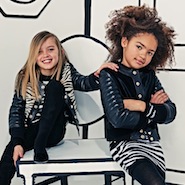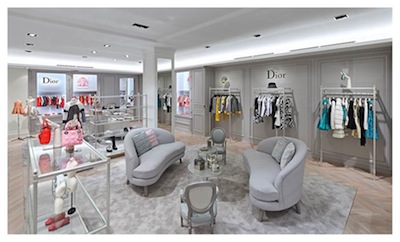 Styles from Balmain's first children's collection
Styles from Balmain's first children's collection
While developing children’s wear may have seemed risky to luxury brands in the past, the market is rife with untapped potential for high-end fashion players, according to a new report by Fashionbi.
"Kidswear Market: Evolution and Potential" explains how a combination of factors, including parents having children at an older and more financially stable age, an increasing birth rate and baby boomer grandparents with the means to dote on their grandchildren, have helped to boost market growth in the children’s wear sector. Over the past couple of years, a number of luxury labels, including Tom Ford and Balmain, have begun designing for younger consumers, appealing to a more brand-conscious generation.
"Parents don't hesitate to give the world to their children today," said Ambika Zutshi, CEO of Fashionbi, Milan.
"With more disposable incomes at hand and having kids later in life, parents have resources enough to support every demand of their beloved child," she said. "That is a good news for the luxury labels, as this means, if they are able to offer the right products catering to this segment, they have a chance to gain yet another loyal customer segment in their portfolio.
"Kids today are much more exposed than ever - to the media, surrounding, celebrity news, kids influencers on Instagram etc. - that they do demand a say in their styling, as well as desire to dress like their favorite celebrity. Hence, if the brands go about satisfying this need, they have a chance to win big.
"Many of the brands have already started to offer even the whole 'family-look,' and they promote it as the best way to bring the families together, in terms of styles, interests or just a shopping experience together."
Fledgling fashionistas
In 2015, the children's wear market in the United States was estimated to have reached $156.8 billion. By 2017, the United Kingdom's children's wear market is projected to climb to about $8.5 billion at current exchange rates. Even with stock market fluctuations, the growth of this category is not expected to slow.
According to the report, Dior was an early adopter of children’s wear, introducing a line in 1967. Back then, it was alone, as the market was dominated with licensed merchandise from the likes of Disney.
Over time, consumer behavior changed and parents began spending more money on children’s clothing. This mostly came about because others have followed Dior's lead in the last decade, including Fendi, Versace, Lanvin, Oscar de la Renta and others.
 Lanvin children's wear
Some brands dipped a toe into children’s wear before adding it as a permanent collection.
One popular tactic was to collaborate with an established children’s wear retailer to produce a limited-edition line. Stella McCartney and Diane von Furstenberg designed for Gap Kids and Gucci used a collection with H&M to raise money for UNICEF. These tests proved commercial successes, and today Gucci and Stella McCartney have permanent kid’s lines.
Parents are the main purchasers, but children hold a lot of sway in shaping their buying decisions. Kids with their own money have also been known to splurge on a fashion item.
Children today are more aware of luxury brands. They are exposed to fashion media from a young age, treated more like adults and taken on international trips.
Lanvin children's wear
Some brands dipped a toe into children’s wear before adding it as a permanent collection.
One popular tactic was to collaborate with an established children’s wear retailer to produce a limited-edition line. Stella McCartney and Diane von Furstenberg designed for Gap Kids and Gucci used a collection with H&M to raise money for UNICEF. These tests proved commercial successes, and today Gucci and Stella McCartney have permanent kid’s lines.
Parents are the main purchasers, but children hold a lot of sway in shaping their buying decisions. Kids with their own money have also been known to splurge on a fashion item.
Children today are more aware of luxury brands. They are exposed to fashion media from a young age, treated more like adults and taken on international trips.
 Affluent children go on trips with their parents from a young age
Additionally, high-profile child celebrities have made them more label-conscious (see story).
These famous progeny include Shiloh Jolie-Pitt, Suri Cruise and Britain’s Prince George. Parents and children are willing to buy into the lifestyles of the celebrity offspring, as long as brands do not make an inauthentic endorsement deal.
Older children have become the ambassadors of fashion brands. For instance, Jaden Smith appeared in an advertisement for Louis Vuitton women’s wear, while Brooklyn Beckham recently shot a Burberry fragrance campaign.
Affluent children go on trips with their parents from a young age
Additionally, high-profile child celebrities have made them more label-conscious (see story).
These famous progeny include Shiloh Jolie-Pitt, Suri Cruise and Britain’s Prince George. Parents and children are willing to buy into the lifestyles of the celebrity offspring, as long as brands do not make an inauthentic endorsement deal.
Older children have become the ambassadors of fashion brands. For instance, Jaden Smith appeared in an advertisement for Louis Vuitton women’s wear, while Brooklyn Beckham recently shot a Burberry fragrance campaign.
Brooklyn’s posts on Burberry’s Instagram account achieved eight times more engagement than Burberry typically sees, partially owing to the teen’s 5.9 million followers on the platform. Mini me With their heightened fashion awareness, the way in which brands develop and produce children’s wear has shifted. Clothing looks less specifically childlike and more like a miniature version of what a brand has designed for adults. Some brands have actually created identical garments so that father and son or mother and daughter can dress alike. Dolce & Gabbana created an eveningwear capsule for mothers and daughters this past fall, while its fall/winter 2015 runway show featured adult women and girls strutting down the runway in almost identical apparel.
 Dolce & Gabbana winter 2016 campaign
Other brands that have repurposed adult fabrications and designs for children are Burberry, Fendi and Oscar de la Renta.
Citing Kim Kardashian West’s daughter North as a muse, French fashion house Balmain has introduced its first children’s line.
Balmain creative director Olivier Rousteing announced the collection on his personal Instagram saying, “Welcome to my new Balmain Kids!”, with the brand’s official channels following suit with a personal statement from the designer. As for style, Mr. Rousteing extended Balmain’s military influence typical of its adult collections for the children’s wear line (see story).
"If before little girls and boys were more into the frilly-frocky cuts or the Disney inspired cartoon character patterns, today the taste has evolved," Ms. Zutshi said.
"Today, kids are more interested to dress up as their favorite adults. It could be their parents, elder stylish cousins or the celebrities," she said. "In other words, they demand a mini version of the adult clothing - short dresses, polka dot or animal patterns, fancy shoes and what not.
"All that the brands need, is to realize this high potential and take careful steps. If they do not feel confident to go solo with an independent line yet, go collaboration. As DVF and Stella McCartney did with Gap Kids in the past, or Karen Walker did with Uniqlo - test the waters and understand the scope of improvements.
"Communication also plays a big role. Already, we can see many kids-only accounts on Instagram sharing their daily looks -- of course run by their parents -- but why not treat them as influencers and create a campaign targeting this market? Opportunities are immense, just some work and forecasting is needed."
Also playing into this mini-me trend, British retailer Harrods is focusing on children’s wear with the opening of its Mini Superbrands concept.
Dolce & Gabbana winter 2016 campaign
Other brands that have repurposed adult fabrications and designs for children are Burberry, Fendi and Oscar de la Renta.
Citing Kim Kardashian West’s daughter North as a muse, French fashion house Balmain has introduced its first children’s line.
Balmain creative director Olivier Rousteing announced the collection on his personal Instagram saying, “Welcome to my new Balmain Kids!”, with the brand’s official channels following suit with a personal statement from the designer. As for style, Mr. Rousteing extended Balmain’s military influence typical of its adult collections for the children’s wear line (see story).
"If before little girls and boys were more into the frilly-frocky cuts or the Disney inspired cartoon character patterns, today the taste has evolved," Ms. Zutshi said.
"Today, kids are more interested to dress up as their favorite adults. It could be their parents, elder stylish cousins or the celebrities," she said. "In other words, they demand a mini version of the adult clothing - short dresses, polka dot or animal patterns, fancy shoes and what not.
"All that the brands need, is to realize this high potential and take careful steps. If they do not feel confident to go solo with an independent line yet, go collaboration. As DVF and Stella McCartney did with Gap Kids in the past, or Karen Walker did with Uniqlo - test the waters and understand the scope of improvements.
"Communication also plays a big role. Already, we can see many kids-only accounts on Instagram sharing their daily looks -- of course run by their parents -- but why not treat them as influencers and create a campaign targeting this market? Opportunities are immense, just some work and forecasting is needed."
Also playing into this mini-me trend, British retailer Harrods is focusing on children’s wear with the opening of its Mini Superbrands concept.
 Rendering of Harrods Mini Superbrands concept
The children’s clothing concept is found on the fourth floor in the children’s wear department and mimics the Superbrands adult space on the retailer’s first floor. As with the adult-focused Superbrands, Mini Superbrands will be dedicated to leading luxury labels such as Christian Dior, Gucci and Loro Piana, among many others (see story).
If brands can capture children’s attention and affection from a young age, it could lead to lifelong relationships, particularly if they are already exposed to the label's aesthetic through adult-style apparel.
"Kids love to dress up in the mini clothing versions of their favorite adults," Ms. Zutshi said. "The need of an hour is to be kept in mind before launching a collection.
"Online, a ton of accounts now exist where already the 'style quotient' of the kids can be understood, country-by-country," she said. "Hence, R&D is important before finalizing upon the specific cuts, patterns and styles.
"About marketing, as mentioned above, using kids-influencers can work wonders. For instance, Crocs brand reported the shoes sell-out within hours of Prince George spotted wearing them on a day out with mom, Kate Middleton. Secondly, including parents and family members along with the kids in a campaign can appeal highly to the audience.
"Cross-industry collaborations, such as joining hands with other designers, theme parks or even with the small scale mommy-run online boutiques, can add to the value and positive emotion."
Rendering of Harrods Mini Superbrands concept
The children’s clothing concept is found on the fourth floor in the children’s wear department and mimics the Superbrands adult space on the retailer’s first floor. As with the adult-focused Superbrands, Mini Superbrands will be dedicated to leading luxury labels such as Christian Dior, Gucci and Loro Piana, among many others (see story).
If brands can capture children’s attention and affection from a young age, it could lead to lifelong relationships, particularly if they are already exposed to the label's aesthetic through adult-style apparel.
"Kids love to dress up in the mini clothing versions of their favorite adults," Ms. Zutshi said. "The need of an hour is to be kept in mind before launching a collection.
"Online, a ton of accounts now exist where already the 'style quotient' of the kids can be understood, country-by-country," she said. "Hence, R&D is important before finalizing upon the specific cuts, patterns and styles.
"About marketing, as mentioned above, using kids-influencers can work wonders. For instance, Crocs brand reported the shoes sell-out within hours of Prince George spotted wearing them on a day out with mom, Kate Middleton. Secondly, including parents and family members along with the kids in a campaign can appeal highly to the audience.
"Cross-industry collaborations, such as joining hands with other designers, theme parks or even with the small scale mommy-run online boutiques, can add to the value and positive emotion." 